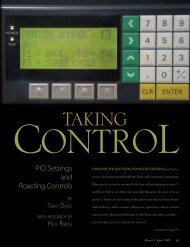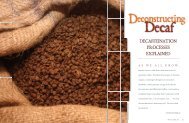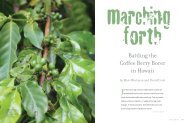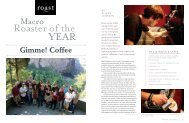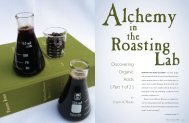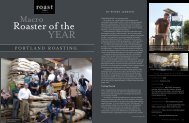to download a low resolution preview of this article - Roast Magazine
to download a low resolution preview of this article - Roast Magazine
to download a low resolution preview of this article - Roast Magazine
You also want an ePaper? Increase the reach of your titles
YUMPU automatically turns print PDFs into web optimized ePapers that Google loves.
market<br />
analysis<br />
C<strong>of</strong>fee Markets May Be Ready for New Highs<br />
by<br />
Maja<br />
Wallengren<br />
For roasters worried about supply, there is little relief in<br />
sight. Fresh crops are going <strong>to</strong> remain in short supply for at<br />
least another year. That means continuing high prices and the<br />
very real likelihood <strong>of</strong> arabica futures prices climbing <strong>to</strong> all-time<br />
his<strong>to</strong>ric highs, which a number <strong>of</strong> analysts believe could reach<br />
$4 <strong>to</strong> $5 per pound. For c<strong>of</strong>fee producers <strong>to</strong> maintain a minimal<br />
margin for stable supply, futures prices need <strong>to</strong> stabilize in a<br />
range between $3.50 and $4 per pound. This is where c<strong>of</strong>fee<br />
growers could see sufficient incentive <strong>to</strong> keep up with basic crop<br />
husbandry. But even such a price level would not generate the<br />
kind <strong>of</strong> massive motivation <strong>to</strong> plant new areas and increase the<br />
acreage <strong>of</strong> the cultivated area worldwide. Many c<strong>of</strong>fee areas were<br />
abandoned for good during the crisis, and what new production<br />
will come in from a short list <strong>of</strong> select growing countries with<br />
the potential <strong>to</strong> expand output will be <strong>of</strong>fset by the slump in<br />
production from a long and growing list <strong>of</strong> countries. Even with<br />
<strong>to</strong>day’s (or higher) prices, <strong>this</strong> list <strong>of</strong> countries will not be able <strong>to</strong><br />
see their crops recover <strong>to</strong> the levels seen before the c<strong>of</strong>fee crisis.<br />
continued on page 26<br />
24 roast September | Oc<strong>to</strong>ber 2011 25
Market Analysis: C<strong>of</strong>fee Markets May Be Ready for New Highs (continued)<br />
Consumption in industrialized<br />
countries has remained strong,<br />
and emerging markets like<br />
Russia, Eastern Europe and<br />
China—as well as key producers<br />
India, Indonesia and Brazil—have<br />
seen a tremendous increase in<br />
c<strong>of</strong>fee drinking in recent years.<br />
C<strong>of</strong>fee prices have been trading near 14-year highs for most<br />
<strong>of</strong> the past year, and many analysts believe it’s only a matter<br />
<strong>of</strong> time before both <strong>this</strong> threshold, as well as the 34-year<br />
high mark, will be reached. Though there is disagreement<br />
about where the market will go in the short term—and some<br />
predict a market decline in the third quarter <strong>of</strong> 2011—those<br />
in the market hoping that prices will come down in the<br />
upcoming fall and winter season may be disappointed.<br />
As the new 2011–12 c<strong>of</strong>fee crops will start arriving from<br />
Central America and bringing fresh supply <strong>to</strong> the market<br />
in November and December, core fundamentals still show<br />
the supply-demand balance at its tightest level in at least 30<br />
years.<br />
Even as the market can see sporadic speculation by<br />
funds and other players pushing prices <strong>to</strong> temporary <strong>low</strong>er<br />
levels, the kind <strong>of</strong> solid crop fundamentals that used <strong>to</strong> be<br />
what dictated price movements in the market are making a<br />
comeback.<br />
“You had a market that was already over $2 [in early 2011]<br />
and continued <strong>to</strong> go higher and in a year when you had a<br />
record Brazil crop. That’s telling you a lot about the c<strong>of</strong>fee<br />
and quality in s<strong>to</strong>re, and the demand in the market,” says<br />
Eric Nadelberg, senior vice president <strong>of</strong> investments, and<br />
head <strong>of</strong> the institutional c<strong>of</strong>fee desk at Prudential Bache<br />
Commodities, LLC.<br />
World c<strong>of</strong>fee production reached 133.3<br />
million 60-kilogram bags in the 2010–11<br />
crop cycle but is predicted <strong>to</strong> fall <strong>to</strong> about<br />
130 million bags in the 2011–12 cycle that<br />
ends on Sept. 30, 2012, according <strong>to</strong> the<br />
International C<strong>of</strong>fee Organization. Despite<br />
the overall recovery in global production<br />
in the last harvest, demand in the same<br />
period has continued <strong>to</strong> increase at levels<br />
well above those <strong>of</strong> production, and<br />
the 2010–11 harvest cycle was the third<br />
consecutive year with a deficit in the<br />
balance.<br />
World demand has continued <strong>to</strong> rise<br />
at an average <strong>of</strong> 2 million bags per year<br />
from 128 million bags in 2007 <strong>to</strong> about 134<br />
million bags in 2010, with the 2011 figure<br />
expected <strong>to</strong> reach at least 136 million bags.<br />
Consumption in industrialized<br />
countries has remained strong, and<br />
emerging markets like Russia, Eastern<br />
Europe and China—as well as key<br />
producers India, Indonesia and Brazil—<br />
have seen a tremendous increase in c<strong>of</strong>fee<br />
continued on page 28<br />
26 roast September | Oc<strong>to</strong>ber 2011 27
Market Analysis (continued)<br />
drinking in recent years. Brazil is closing in on the United States as the world’s largest<br />
consumer in overall volumes, with local industry <strong>of</strong>ficials estimating that local demand<br />
<strong>to</strong>day is near 20 million bags. The consumption in Brazil has increased between 500,000<br />
bags and 1 million bags during the last decade, as compared <strong>to</strong> a local consumption <strong>of</strong><br />
about 14 million bags in 2001 and 2002.<br />
At the end <strong>of</strong> the day, prices can only be kept artificially at <strong>low</strong>er levels for so long<br />
before the c<strong>of</strong>fee has <strong>to</strong> be physically delivered. When that moment arrives for those who<br />
are short, it will be expensive because the c<strong>of</strong>fee needed <strong>to</strong> deliver the volumes required<br />
<strong>to</strong> maintain basic price and supply stability is not there. And there is no realistic<br />
possibility <strong>to</strong> see any surplus in the market materializing until the end <strong>of</strong> 2012 when the<br />
then 2012–2013 crop cycle starts.<br />
“The c<strong>of</strong>fee isn’t there, and the market is facing structural deficits that, because <strong>of</strong><br />
the nature <strong>of</strong> the c<strong>of</strong>fee trees itself, means the supply can’t respond as aggressively as the<br />
market is requiring. Going forward in the next three years, I don’t see any replenishing<br />
<strong>of</strong> the supply,” Nadelberg says.<br />
“Basically it’s spot market players that keep the market buoyant, and I don’t think<br />
the market will have a problem <strong>to</strong> move significantly above three dollars in terms <strong>of</strong> the<br />
way the fundamentals look,” he adds.<br />
Monthly demand by importing countries and roasters is <strong>to</strong>day at between 7.5 million<br />
and 8 million bags. Even in the best <strong>of</strong> cases—with a bumper crop from Brazil and decent<br />
crops from Mexico, Colombia, Central America and Peru—the monthly export volumes<br />
from these key Latin American<br />
arabica producers will in the<br />
new 2011–12 cycle barely be able<br />
<strong>to</strong> surpass 5 million bags, and<br />
that is when the crops are at<br />
their peaks. Add the relatively<br />
small arabica volumes from East<br />
Africa and India in addition <strong>to</strong><br />
robusta beans from Vietnam,<br />
Indonesia and Africa, and the<br />
basic minimum world import<br />
demand will, in the most<br />
optimistic <strong>of</strong> forecasts, more or<br />
less break even.<br />
This, however, does not<br />
include the supply needed <strong>to</strong><br />
fulfill the fast-growing demand<br />
in producing countries, which<br />
takes the <strong>to</strong>tal monthly world<br />
demand <strong>to</strong> between 11 million<br />
and 11.5 million bags. Or even<br />
fewer, if any surplus c<strong>of</strong>fee is<br />
used <strong>to</strong> rebuild depleted world<br />
s<strong>to</strong>cks. The precarious balance<br />
will leave no room for crop<br />
failures, and reports <strong>of</strong> even<br />
the slightest damage or harvest<br />
complication will serve as a<br />
trigger that has the potential <strong>to</strong><br />
send the market in<strong>to</strong> a panic.<br />
“Anything is possible<br />
here,” says Marco Ruttimann,<br />
a partner in the Miamibased<br />
brokerage C<strong>of</strong>fee-Link<br />
International. “The imbalance<br />
U.S. c<strong>of</strong>fee retailers<br />
and roasters are<br />
already under pressure<br />
from a 50-percent<br />
hike in prices for green<br />
beans in the last four<br />
months, as consumer<br />
prices in the same<br />
period have been<br />
raised only about<br />
20 percent.<br />
in the supply-demand picture is so precarious that anything that might go wrong at <strong>this</strong><br />
stage in producing countries, especially in Colombia and Brazil, could send <strong>this</strong> market<br />
flying <strong>to</strong> levels never dreamed before.”<br />
Jack Scoville, vice president <strong>of</strong> the Chicago-based Price Futures Group, is one <strong>of</strong><br />
many who believes it’s not a question <strong>of</strong> if but when the market will next rally. And<br />
many <strong>of</strong> those driving the market are simply not aware <strong>of</strong> how tight supply is, which<br />
could add <strong>to</strong> the alarm.<br />
“Fundamentals suggest high prices for another year or so,” Scoville says. “When the<br />
blessed rally might happen is hard <strong>to</strong> say, but I think sooner rather than later. A disaster<br />
or some kind could push prices up <strong>to</strong> the $3.65–$3.70 area.”<br />
“We will look for better crops in Central America, but probably not get them,”<br />
Scoville adds. “The amount <strong>of</strong> investment by farmers there has been a disappointment,<br />
and the big guys have been buying. But the specula<strong>to</strong>rs might not realize just how tight<br />
things will stay after September until we get closer <strong>to</strong> the date. Once people realize the<br />
c<strong>of</strong>fee is already gone, then we can see the last run.”<br />
U.S. c<strong>of</strong>fee retailers and roasters are already under pressure from a 50-percent<br />
hike in prices for green beans in the last year, as consumer prices in the same period<br />
have been raised only about 20 percent, says veteran Brazilian c<strong>of</strong>fee trader Christian<br />
Wolthers <strong>of</strong> Florida-based arabica importer Wolthers America Inc.<br />
“The situation is chaotic, and I can’t see any relief in the next many months because<br />
all the c<strong>of</strong>fee is in the hands <strong>of</strong> the producers,” Wolthers says. “I am telling my clients<br />
that every time the market dips, it’s a buying opportunity and they should buy as much<br />
c<strong>of</strong>fee as they can, because next time the market dips, it will be from a higher level.”<br />
When the market approached the new Brazil crop in May <strong>this</strong> year, prices reached<br />
a then-high <strong>of</strong> $3.09. Analysts agree that once prices <strong>to</strong>p the 14-year highs <strong>of</strong> May 1997,<br />
when the New York c<strong>of</strong>fee market hit $3.18 per pound, it will be a short distance <strong>to</strong> <strong>to</strong>p<br />
the 34-year highs <strong>of</strong> $3.37 per pound reached in April 1977 and then move on <strong>to</strong> new<br />
his<strong>to</strong>ric highs.<br />
To make matters worse for U.S. roasters, which in most cases sit on a maximum<br />
<strong>of</strong> four <strong>to</strong> eight weeks <strong>of</strong> supply, producers are in no hurry <strong>to</strong> sell the little fresh<br />
supply coming out. This will put further pressure on arabica futures, according <strong>to</strong> the<br />
independent Colombian c<strong>of</strong>fee analyst Pedro Echavarria.<br />
continued on page 30<br />
28 roast September | Oc<strong>to</strong>ber 2011 29
Market Analysis: C<strong>of</strong>fee Markets May Be Ready for New Highs (continued)<br />
“The Central American producers<br />
feel they got burned when they sold their<br />
[2010–11] crop early at between $2.30 and<br />
$2.40, which was seen as a great selling<br />
opportunity at the time. But when the<br />
new harvest started, the market opened<br />
at a range between $2.40 and $2.60, and<br />
producers now understand that the market<br />
is in a serious deficit situation,” says<br />
Echavarria.<br />
He said that with the smaller crop in<br />
Brazil as well as in key producers like Peru,<br />
India and Indonesia, and continuing crop<br />
failure for the third consecutive year in<br />
Colombia, analysts like him are wondering<br />
where any fresh supply will come from once<br />
the current Brazil crop is sold.<br />
What’s more, producing countries in<br />
both Central America and East Africa also<br />
continue <strong>to</strong> struggle <strong>to</strong> recover even basic<br />
output levels, and the regional-based<br />
crop average from both arabica areas is<br />
still significantly under volume (by 20 <strong>to</strong><br />
30 percent) <strong>of</strong> that seen in the late 1990s.<br />
This is an important detail because there<br />
are no other countries or regions in the<br />
world with the potential <strong>to</strong> provide any<br />
significant backup supply <strong>of</strong> arabica.<br />
Arabica provides for 65 <strong>to</strong> 70 percent <strong>of</strong><br />
<strong>to</strong>tal global demand for c<strong>of</strong>fee, with the<br />
balance largely made up by robusta.<br />
The International C<strong>of</strong>fee Organization<br />
estimates that s<strong>to</strong>cks in importing<br />
countries prior <strong>to</strong> the start <strong>of</strong> the current<br />
Brazil harvest now under way were at<br />
his<strong>to</strong>ric <strong>low</strong>s <strong>of</strong> about 13 million bags.<br />
This is the equivalent <strong>of</strong> just over one<br />
month’s world demand <strong>of</strong> about 11.2<br />
million bags and represents the <strong>low</strong>est in<br />
his<strong>to</strong>ry based on known statistics.<br />
When the market hit $3.18 per pound<br />
in 1997, importing countries had about<br />
20 million bags <strong>of</strong> s<strong>to</strong>ck <strong>to</strong> draw on from<br />
producing countries. But at the moment,<br />
there are no inven<strong>to</strong>ries left in the hands<br />
<strong>of</strong> growers and what little new crops are<br />
being produced are practically sold and<br />
shipped before they are even picked.<br />
“The arabica c<strong>of</strong>fee market<br />
continues <strong>to</strong> be a ticking time bomb<br />
with a short fuse that any unexpected<br />
supply disruption could set <strong>of</strong>f,” says<br />
commodities analyst Judith Ganes-Chase,<br />
<strong>of</strong> J. Ganes Consulting. “In 1997, producers<br />
had plenty <strong>of</strong> c<strong>of</strong>fee <strong>to</strong> ship in<strong>to</strong> the rally<br />
<strong>to</strong> cool it immediately, and now they<br />
don’t. <strong>Roast</strong>ers’ ability <strong>to</strong> shift <strong>to</strong> cheaper<br />
robusta is also hindered because they’ve<br />
done <strong>this</strong> already.”<br />
Echavarria agrees and adds that<br />
with the continuing crop problems in<br />
Colombia, there is no easy fix <strong>to</strong> the<br />
current situation.<br />
Contrary <strong>to</strong> public reports from<br />
Colombian c<strong>of</strong>fee <strong>of</strong>ficials—and the U.S.<br />
Department <strong>of</strong> Agriculture, which is<br />
forecasting a 10-percent rise in production<br />
for 2011–2012—the c<strong>of</strong>fee harvest <strong>of</strong><br />
the world’s largest producer <strong>of</strong> <strong>to</strong>pquality<br />
arabica beans has not made any<br />
significant level <strong>of</strong> recovery.<br />
Analysts and industry <strong>of</strong>ficials in<br />
both Colombia and elsewhere point out<br />
that even if the overall crop volume from<br />
Colombia may rise between 5 percent and<br />
10 percent, <strong>this</strong> will take the <strong>to</strong>tal harvest<br />
<strong>to</strong> about 9 or 9.5 million bags. And that<br />
can hardly be described as a recovery for a<br />
country that used <strong>to</strong> produce between 11.5<br />
and 13.5 million bags just a few years ago.<br />
Furthermore, even if <strong>this</strong> modest increase<br />
materializes, it won’t al<strong>low</strong> for s<strong>to</strong>cks <strong>to</strong><br />
refill.<br />
Despite an improvement in<br />
production and export figures in<br />
Colombia’s main crop that ended in<br />
January <strong>this</strong> year, <strong>this</strong> was <strong>of</strong>fset with<br />
what producers and traders alike agree is<br />
one <strong>of</strong> the worst “mitaca” mid-crops in<br />
the country’s his<strong>to</strong>ry.<br />
“Colombia didn’t have a mitaca <strong>this</strong><br />
year; in the best case, it will be as good<br />
as 2008, which was the worst in his<strong>to</strong>ry,”<br />
says Echavarria.<br />
Increasing production is not an<br />
option <strong>to</strong> ease the current supply squeeze,<br />
because even if heavy investments in<strong>to</strong><br />
new plantings and renovation <strong>of</strong> farms<br />
are made, these efforts won’t result in<br />
more c<strong>of</strong>fee until three or four years from<br />
now.<br />
The countries with both the land<br />
and labor available <strong>to</strong> enable any<br />
significant expansion <strong>of</strong> production<br />
include Tanzania, Vietnam, Honduras,<br />
Peru and Brazil. And while only Brazil<br />
can count on the investment needed <strong>to</strong><br />
undertake any serious expansion, most<br />
industry observers in Brazil doubt that<br />
will happen.<br />
“It will take three <strong>to</strong> four years for<br />
Brazil <strong>to</strong> increase production if prices stay<br />
high, which I believe they will for quite<br />
a long time,” says Luiz Hafers, a veteran<br />
analyst in Brazil and currently the<br />
direc<strong>to</strong>r <strong>of</strong> the Brazilian Rural Society’s<br />
c<strong>of</strong>fee department. He adds that given<br />
the current supply-demand balance, and<br />
no realistic possibility for any significant<br />
recovery in world production for several<br />
years, prices could even rise <strong>to</strong> $4 or $5 per<br />
pound.<br />
Hafers points out that the last time<br />
Brazilian c<strong>of</strong>fee producers embarked on<br />
a serious expansion effort, both the price<br />
and production incentive was boosted<br />
by the fact that there were few other<br />
alternatives. “But <strong>this</strong> is not the case<br />
<strong>to</strong>day,” he adds. “Sugar cane, grains and<br />
forestry all compete for investment, and,<br />
last but not least, labor for c<strong>of</strong>fee is and<br />
will be very difficult.”<br />
So what will it take <strong>to</strong> get producers<br />
sufficiently interested in increasing<br />
production <strong>to</strong> meet the continually<br />
growing consumption levels?<br />
Echavarria says prices need <strong>to</strong> be<br />
adjusted <strong>to</strong> 30 years <strong>of</strong> inflation, which<br />
have yet <strong>to</strong> catch up with the current<br />
prices. C<strong>of</strong>fee prices were initially fixed<br />
at a minimum $1.20 per pound during<br />
the Cold War-era pact on quotas and<br />
prices between importing and exporting<br />
countries.<br />
If prices during the International C<strong>of</strong>fee<br />
Agreement from 1962 <strong>to</strong> 1989 were trading at a<br />
fixed minimum <strong>of</strong> $1.20 per pound, analysts<br />
say, then a modest 3-percent annual inflation<br />
rate <strong>to</strong>day puts c<strong>of</strong>fee prices at between $3.50<br />
and $4 per pound. And that is a conservative<br />
calculation, as that price range does not<br />
incorporate the much sharper inflationary<br />
increase in petroleum prices, which make<br />
continued on page 32<br />
30 roast September | Oc<strong>to</strong>ber 2011 31
Market Analysis: C<strong>of</strong>fee Markets May Be Ready for New Highs (continued)<br />
up a major component <strong>of</strong> c<strong>of</strong>fee production for inputs such<br />
as fertilizer, the operation <strong>of</strong> machinery and mills, and the<br />
transportation <strong>of</strong> workers.<br />
“If we look at the c<strong>of</strong>fee prices nowadays and compare<br />
them with prices 10, 20 years ago, it’s easy <strong>to</strong> conclude that $3<br />
is nothing special at the end <strong>of</strong> the day,” says Joaquim Libanio<br />
Leite, export direc<strong>to</strong>r for the Cooxupe cooperative in Minas<br />
Gerais state, the world’s largest c<strong>of</strong>fee cooperative in charge <strong>of</strong><br />
about 15 percent <strong>of</strong> Brazil’s output.<br />
Both Hafers and Echavarria also agree that the devaluation<br />
<strong>of</strong> local currencies in the face <strong>of</strong> a weak dollar presents yet<br />
another challenge for those who want <strong>to</strong> argue the possibility<br />
<strong>of</strong> a lasting correction <strong>to</strong> the current market.<br />
“We need <strong>to</strong> look at the dollar because devaluation is a fact,”<br />
said Hafers, while Echavarria adds: “All the major producing<br />
countries, like Brazil and Colombia, have strongly devalued<br />
currencies. So what is $3.70 in an inflation-adjusted price needs <strong>to</strong><br />
be $4.50 in Colombia <strong>to</strong> reflect <strong>this</strong>.”<br />
In July 2011, Colombia’s peso traded at 1,760 <strong>to</strong> the U.S. dollar,<br />
a significant appreciation from February 2009, when the peso was<br />
trading at 2,600 per dollar. Brazil’s real, similarly, went from 2.45<br />
<strong>to</strong> the dollar in December 2008 <strong>to</strong> 1.55 per dollar in July 2011.<br />
Once the new 2011–2012 East African and Latin American<br />
C<strong>of</strong>fee consumers will still need<br />
their daily cup <strong>of</strong> c<strong>of</strong>fee, and<br />
there is no magical solution as <strong>to</strong><br />
where the beans will come from.<br />
arabica crops start <strong>to</strong> reach the market in the coming months,<br />
roasters, importers and brokers will all need <strong>to</strong> position themselves<br />
for the fall season. During the last quarter <strong>of</strong> the year, from Oc<strong>to</strong>ber<br />
<strong>to</strong> December, 45 percent <strong>of</strong> the year’s roasting is done. And analysts<br />
expect it will be a buying frenzy when everyone tries <strong>to</strong> secure their<br />
supply <strong>of</strong> crops in a market that won’t produce enough <strong>to</strong> satisfy<br />
all.<br />
For major roasters such as Starbucks, Kraft Foods and Folgers<br />
C<strong>of</strong>fee, as well as the small and medium-sized companies, the<br />
pipeline <strong>of</strong> fresh supply could dry up before any new big crop<br />
will provide the market with relief.<br />
“Fundamentally speaking, we have in the past 50 years not<br />
seen <strong>this</strong> level <strong>of</strong> such major shortage in terms <strong>of</strong> the structural<br />
producing capacity currently available in the world, and prices<br />
are headed <strong>to</strong>ward $4 per pound,” says Echavarria.<br />
Some analysts and parts <strong>of</strong> the trade believe that if<br />
f<strong>low</strong>ering is favorable for the 2012–13 crop in Brazil, which next<br />
year will embark on an up-cycle with a big harvest, then <strong>this</strong><br />
could see the market revert <strong>to</strong> a more bearish trend.<br />
“It’s difficult <strong>to</strong> say how high is high, but easier <strong>to</strong> pinpoint<br />
a potential turning point and an end <strong>to</strong> <strong>this</strong> multi-year bull<br />
market. A frost-free winter in Brazil and successful f<strong>low</strong>ering <strong>of</strong><br />
the 2012–13 crop could do the trick,” said Ganes-Chase.<br />
A big Brazil crop is expected <strong>to</strong> start reaching the market<br />
by June 2012. But that is still far <strong>of</strong>f—and it will be little<br />
consolation for roasters and importers that a big Brazil crop will<br />
arrive by June if by March or April there is no fresh supply left <strong>to</strong><br />
buy in the market. C<strong>of</strong>fee consumers will still need their daily<br />
cup <strong>of</strong> c<strong>of</strong>fee, and there is no magical solution as <strong>to</strong> where the<br />
beans will come from.<br />
Maja Wallengren started writing about c<strong>of</strong>fee 17 years ago and<br />
has, during years <strong>of</strong> c<strong>of</strong>fee travels, covered a variety <strong>of</strong> c<strong>of</strong>fee issues firsthand<br />
from more than 40 producing countries in Southeast Asia, East and West<br />
Africa, and Latin America. She is based in Mexico City and can be reached at<br />
mwallengren@hotmail.com.<br />
Edi<strong>to</strong>r’s Note: The opinions expressed in <strong>this</strong> <strong>article</strong> do not<br />
necessarily represent the views <strong>of</strong> <strong>Roast</strong> magazine.<br />
32 roast September | Oc<strong>to</strong>ber 2011 33



